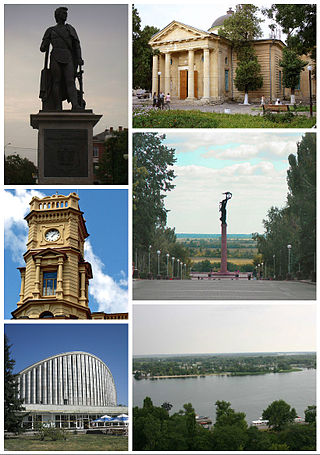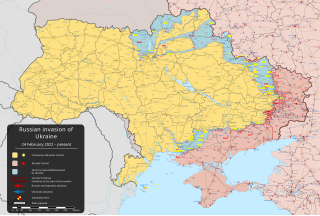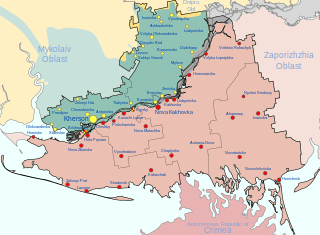Related Research Articles

Kherson is a port city in Ukraine that serves as the administrative centre of Kherson Oblast. Located by the Black Sea and on the Dnieper River, Kherson is the home to a major ship-building industry and is a regional economic centre. At the beginning of 2022, its population was estimated at 279,131.
Drone warfare is a form of warfare using robots. Robot types include: unmanned combat aerial vehicles (UCAV) or weaponized commercial unmanned aerial vehicles (UAV), unmanned surface vehicles, and ground based drones. The United States, United Kingdom, Israel, China, South Korea, Iran, Iraq, Italy, France, India, Pakistan, Russia, Turkey, Ukraine and Poland are known to have manufactured operational UCAVs as of 2019.

Zarina Zabrisky is an American writer based in the Bay Area, California. She is the author of the novel, We, Monsters, several collections of short stories, including Explosion, A Cute Tombstone and her debut work, Iron, and a book of collaborative poetry and art, Green Lions, co-written with Simon Rogghe. Zabrisky resides in San Francisco, California.

Russian war crimes are violations of international criminal law including war crimes, crimes against humanity and the crime of genocide which the official armed and paramilitary forces of Russia have committed or been accused of committing since the dissolution of the Soviet Union in 1991, as well as the aiding and abetting of crimes by proto-statelets or puppet statelets which are armed and financed by Russia, including the Luhansk People's Republic and the Donetsk People's Republic. These have included murder, torture, terror, persecution, deportation and forced transfer, enforced disappearance, child abductions, rape, looting, unlawful confinement, inhumane acts, unlawful airstrikes and attacks against civilian objects, use of banned chemical weapons, and wanton destruction.
Casualties in the Russo-Ukrainian War include six deaths during the 2014 annexation of Crimea by the Russian Federation, 14,200–14,400 military and civilian deaths during the War in Donbas, and up to 1,000,000 estimated casualties during the Russian invasion of Ukraine till mid-September 2024.

On 24 February 2022, Russia invaded Ukraine in a major escalation of the Russo-Ukrainian War, which started in 2014. The invasion, the largest and deadliest conflict in Europe since World War II, has caused hundreds of thousands of military casualties and tens of thousands of Ukrainian civilian casualties. As of 2024, Russian troops occupy about 20% of Ukraine. From a population of 41 million, about 8 million Ukrainians had been internally displaced and more than 8.2 million had fled the country by April 2023, creating Europe's largest refugee crisis since World War II.
The battle of Kherson began on 24 February 2022, as part of the southern Ukraine campaign of the Russian invasion of Ukraine. The city of Kherson was captured by Russian forces on 1 March 2022. Russia then began a military occupation of the area.

Since the beginning of the Russian invasion of Ukraine in 2022, the Russian military and authorities have committed war crimes, such as deliberate attacks against civilian targets, including on hospitals, medical facilities and on the energy grid; indiscriminate attacks on densely-populated areas; the abduction, torture and murder of civilians; forced deportations; sexual violence; destruction of cultural heritage; and the killing and torture of Ukrainian prisoners of war.

The ongoing military occupation of Ukraine's Kherson Oblast by Russian forces began on 2 March 2022 during the Russian invasion of Ukraine as part of the southern Ukraine campaign. It was administrated under a Russian-controlled military-civilian administration until 30 September 2022, when it was illegally annexed to become an unrecognized federal subject of Russia.

There have been attacks in mainland Russia as a result of the Russian invasion of Ukraine, which began on 24 February 2022. The main targets have been the military, the arms industry and the oil industry. Many of the attacks have been drone strikes, firebombing, and rail sabotage. The Ukrainian intelligence services have acknowledged carrying out some of these attacks. Others have been carried out by anti-war activists in Russia. There have also been cross-border shelling, missile strikes, and covert raids from Ukraine, mainly in Belgorod, Kursk, and Bryansk oblasts. Several times, Ukrainian-based paramilitaries launched incursions into Russia, captured border villages and battled the Russian military. These were carried out by units made up mainly of Russian emigrants. While Ukraine supported these ground incursions, it denied direct involvement.
During the Russian invasion of Ukraine, Russia occupied vast portions of the territory of Ukraine, having already occupied parts of the Donetsk and Luhansk oblasts as well as the entire Autonomous Republic of Crimea since the beginning of the Russia-Ukraine war in 2014. Partisan groups began to be organized in mid-2022. These groups have been involved in intelligence-gathering, sabotage, and assassinations. Much of their activity has taken place in the Kherson and Zaporizhzhia regions.
The attack to the care house in Stara Krasnianka took place on 11 March 2022 during the Russian invasion of Ukraine. On 7 March the Ukrainian armed forces occupied a care house in the village of Stara Krasnianka, near Kreminna, Luhansk region, establishing a firing position and reportedly leaving the patients unevacuated due to the presence of mines. On 11 March 2022 pro-Russian separatist forces attacked the care house with heavy weapons while 71 patients with disabilities and 15 members of staff were still inside. A fire broke out and fifty six civilians died.

During the 2022 Russian invasion of Ukraine, the Russian Armed Forces have launched several missile attacks over the city of Dnipro in Ukraine. These have led to dozens of fatalities and over a hundred injuries among the civilian population.

During the Russian invasion of Ukraine, the Russian military have carried out deliberate attacks against civilian targets and indiscriminate attacks in densely-populated areas. The United Nations Human Rights Monitoring Mission in Ukraine says the Russian military exposed the civilian population to unnecessary and disproportionate harm by using cluster bombs and by firing other weapons with wide-area effects into civilian areas, such as missiles, heavy artillery shells and multiple launch rockets. As of 2024, the attacks had resulted in the UN-documented deaths of between 11,000 and estimated 40,000 dead civilians. On 22 April 2022, the UN reported that of the 2,343 civilian casualties it had been able to document, it could confirm 92.3% of these deaths were as a result of the actions of the Russian armed forces.
This timeline of the Russian invasion of Ukraine covers the period from 29 August 2022, when Ukraine's Kherson counteroffensive started, to 11 November 2022 when Ukrainian troops retook Kherson. In between, Ukraine launched a successful counteroffensive in Kharkiv Oblast. Starting in October, Russia began a campaign of massive strikes against Ukrainian infrastructure.

Dudchany is a village located in Beryslav Raion, Kherson Oblast, Ukraine. It is located in the northwest of the oblast on the right bank of the Dnieper. The village had a pre-war population of 2,043 according to the 2001 Ukrainian Census, and was known for its watermelon growing.

Beginning in July 2022, a series of explosions and fires occurred on the Russian-occupied Crimean Peninsula, from where the Russian Army had launched its offensive on Southern Ukraine during the Russian invasion of Ukraine. Occupied since 2014, Crimea was a base for the subsequent Russian occupation of Kherson Oblast and Russian occupation of Zaporizhzhia Oblast.

Russia launched waves of missile and drone strikes against energy in Ukraine as part of its invasion. From 2022 the strikes targeted civilian areas beyond the battlefield, particularly critical power infrastructure, which is considered a war crime. By mid-2024 the country only had a third of pre-war electricity generating capacity, and some gas distribution and district heating had been hit.

On 11 November 2022, the Armed Forces of Ukraine liberated and recaptured the city of Kherson and other areas of the Kherson Oblast and parts of the Mykolaiv Oblast on the right bank of the Dnipro River from Russian control. The Russian Armed Forces, which had occupied the city since 2 March 2022, withdrew and retreated to the left bank of the Kherson Oblast over the course of 9–11 November 2022.

During the illegal Russian invasion of Ukraine The Russian Military has repeatedly attacked Ukrainian medical facilities, hospitals, clinics, and ambulances, and health workers. The Ministry of Defense of the United Kingdom stated that Russia was prioritizing attacks on Ukrainian medical facilities as a method of warfare, often striking these, as well as power infrastructure with Iranian-made drones such as Shahed 131, Shahed 136.
References
- 1 2 3 4 5 6 Hambling, David (11 October 2024). "Terrifying 'Human Safari' In Kherson As Russian Drones Hunt Civilians". Forbes. Retrieved 29 October 2024.
- 1 2 3 Zivo, Adam (9 October 2024). "Russian drones are hunting civilians in Ukraine". National Post. Retrieved 29 October 2024.
- ↑ "'Human safari': Kherson residents on constant drone warfare". ABC listen. 10 October 2024. Retrieved 29 October 2024.
- ↑ Kelly, Kieran (5 October 2024). "Russian drones hunt civilians in Kherson 'safari'". The Telegraph. Retrieved 29 October 2024.
- 1 2 3 Zabrisky, Zarina (2 October 2024). "'Human safari' – Kherson civilians hunted down by Russian drones". Yahoo News. Retrieved 29 October 2024.